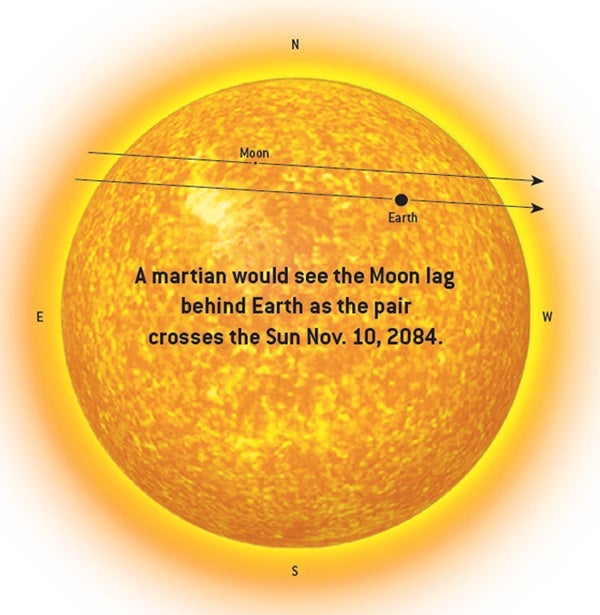We’re now in the longest gap of this series. Science-fiction writer Arthur C. Clarke featured the last event — which occurred May 11, 1984 — in a 1971 short story. In the tale, a fateful Mars mission’s last surviving astronaut witnesses the transit before exhausting his air supply. Although Clarke was overly optimistic about human visits to Mars, astronauts — or long-lived rovers — may see the next Earth transit November 10, 2084.
Earth transits have occurred only in May and November since the 17th century. This will continue into the next millennium. For a transit to occur, Mars, Earth, and the Sun must align when Mars lies near one of the points where its tilted orbit cuts through the ecliptic — the plane of Earth’s orbit.
May transits occur when Mars passes beneath the ecliptic, at its orbit’s descending node. November transits occur when Mars is near its ascending node, crossing the ecliptic from below. Because the Sun, Earth, and Mars align during a transit, Mars always is at opposition — and at its brightest for observers on Earth.
Earth in transit will appear smaller in martian skies (36″) than Venus did from Earth in the June 2004 transit (58″). Astronauts would need a telescope and appropriate solar filters to watch our planet glide across the Sun’s face.
What makes Earth transits unique, however, is that each usually is accompanied by a transit of our Moon. Depending on the Moon’s phase, it can either precede or follow Earth across the Sun. In rare cases, the Moon can transit so far ahead (November 8, 1800) or so far behind (May 10, 2394) Earth that both bodies cannot be seen together on the Sun.
Seeing Earth and the Moon in transit would demonstrate dramatically just how large a gulf separates the two worlds — and for an astronaut on Mars, it also would be a reminder of how far away home really is. — FRANCIS REDDY, ASSOCIATE EDITOR










